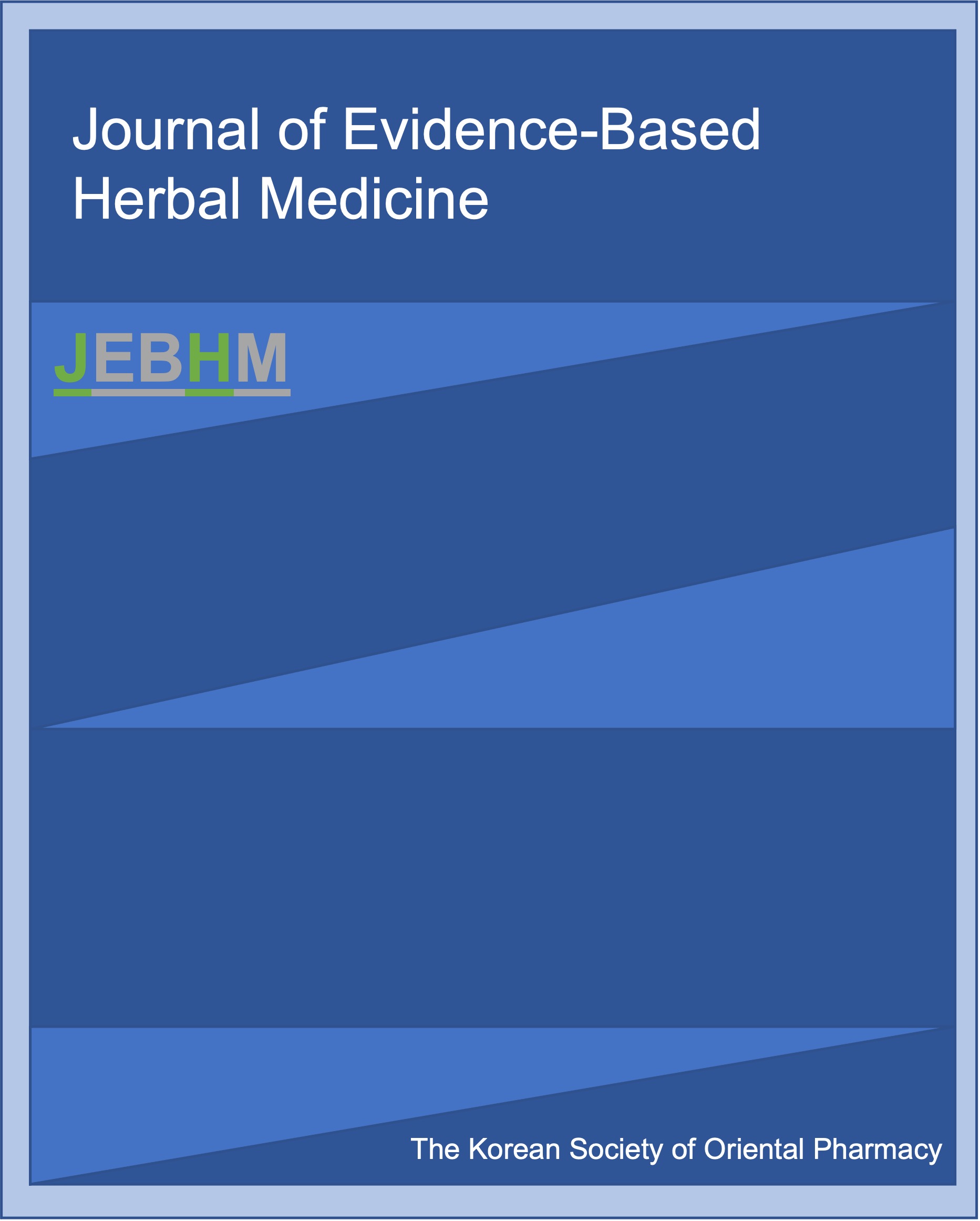 ISSN : 1976-9849
ISSN : 1976-9849
Vol.2 No.1
Abstract
Objectives : The purpose of this study was to investigate the anti-inflammatory effects of Ecklonia cava butanol extract (BFEC) on RAW 264.7 cells. Method : To evaluate of anti-inflammatory of BFEC, We examined cytokine and Nitric oxide(NO) production in lipopolysacchride (LPS)-induced RAW 264.7 cell. Result : Extract of BFEC inhibit LPS-induced interleukin (IL)-6, NO production in human monocyte RAW 264.7 cells. Conclusion : BFEC down-regulated LPS-induced IL-6, NO production, which may be provide a clinical basis for anti-inflammatory properities of BFEC.
Abstract
Velvet antlers from Cervus elaphus species are one of most famous, expensive and commonly used medicinal materials in traditional oriental medicine. Some distributor had illegal practice of disguising the origin of antlers in Korea market. Therefore, a test to distinguish antler essential to ensure the healthy development of the herbal industry. In this study, the variation in DNA sequences of the mitochondrial ATPase8 and cytochrome-coxidaseI (COI) genes of Cervus elaphus from China, the Republic of Altai, and Canada were evaluated. In addition, the sequence variation among, Rein deer and Cervus elaphus species was also evaluated. Although the sequences of deer from the Republic of Altai and Canada were very similar, polymorphisms that were conserved in each species were observed in the ATPase8 and COI genes. Therefore, these polymorphic markers could be used to distinguish Cervus elaphus antlers from different locations.
Abstract
The aim of this study was to find out the time when the Araliae Continentalis Radix and Osterici Radix were classified into different divisions as the period were not known to oriental medical science in Korea. It could be said that the Araliae Continentalis Radix and Osterici Radix had been recognized the different shapes since Sui-Tang eras and they had been differently used in their shapes and effects as separated medical plants since Song-Yuan eras. This thesis also presented the effects and shapes of Araliae Continentalis Radix and Osterici Radix as well as showed prescriptions and the uses of them in each dynasty of China.
Abstract
GD68 is newly developed herb complex prescription. The constituent herbs of GD68 were Massa Medicata Fermentata, Atractylodis Rhizoma Alba, Poria, Zingiberis Siccatum Rhizoma, Crataegi Fructus, Saccarum Granorum, Agastachis Herba, Taraxaci Herba, Perillae Herba, Scutellariae Radix, Astragali Radix, Ginseng Radix, Houttuyniae Herba and Halloysitum Rubrum. The aim of this study was to examine feed value of GD68 in duck. The weight gain of ducks fed with supplemental GD68 high compared to those of the control. The feed intake and mortality of ducks fed with supplemental GD68 low compared to those of the control. The moisture, crude lipid and calorie content of the ducks fed GD68 were decreased, but the crude protein content of the ducks fed GD68 was increased. And we investigated the effect of GD68 on the production of cytokines in human T-cell line, MOLT-4 cells. GD68 plus concanavalin A (Con A) increased the interferon-<TEX>$\gamma$</TEX> and interleukin-2 production compared with Con A alone. These results indicate that the supplemental GD68 may improve the production, meat quality and immunity of ducks.
Abstract
The origin and description of the Herba Plantaginis was contemporarily analyzed (family names, scientific names, target regions, preparation, etc.) by comparison to enormous literature in addition to the external features written in the existing books on traditional Korean medicine. Also, galenical description were analyzed in connection with external morphology, internal morphology, microscopy and five senses. The official documents and ancient documents of other countries were reviewed. The technical books on herbage, published in the country and other countries, were compared with each other. Also, on-the-spot surveys were made to learn specialists' know-how. The description of the collected drugstuffs were analyzed in connection with external morphology (size, color, etc.), internal morphology and microscopy. The results of this study can be applied to the publicity and education of galenical test agencies; the effective management of foods and drugs; the improvement of public medical service; the publicity of galenical safety.
Abstract
Sodium arsenate and Yeonlyeonggobon-dan (nianlinggubendan) extract, a herbal restorative were treated p.o. 20mg/kg and 500mg/kg respectively and concurrently to rats, and examined the variation of the body weight and the accumulation of arsenic in organs. Yeonlyeonggobon-dan (nianlinggubendan) extract(YGD) resulted in the increase of body weight, and the increase ratio of body weight in arsenic-treated group was dropped but the group of concurrent administration with YGD showed significant recovery. The ratio of liver weight / body weight of arsenic-treated group increased but the group of concurrent administration with YGD showed significant decrease. The accumulation of arsenic in liver and kidney of arsenic-treated group increased but the group of concurrent administration with YGD showed significant decrease.
Abstract
Sodium arsenate and Yeonlyeonggobon-dan (nianlinggubendan) extract (YGD), a herbal restorative were treated p.o. 20 mg/kg and 500 mg/kg, respectively, and concurrently to rats, and examined the biochemical parameters in blood. The values of white blood cell (WBC), red blood cell (RBC), hemoglobin (Hgb) and hematocrit (Hct) in each group did not show significant variance. The value of aspartate aminotrasferase (AST) of arsenic-treated group was increased for 2 weeks significantly while that of the group of concurrent administration with YGD became low significantly compared with arsenic-treated group and the value of alkaline phosphatase (ALP) of arsenic-treated group was decreased while that of the group of concurrent administration with YGD was increased significantly compared with arsenic-treated group. In arsenic-treated groups, the value of glucose (Glu), and those of lactic dehydrogenase (LDH), blood urea nitrogen (BUN) and triglyceride (TG) were decreased at first but increased later while the groups of concurrent administration with YGD showed significant recovery from the toxicity of arsenic.
